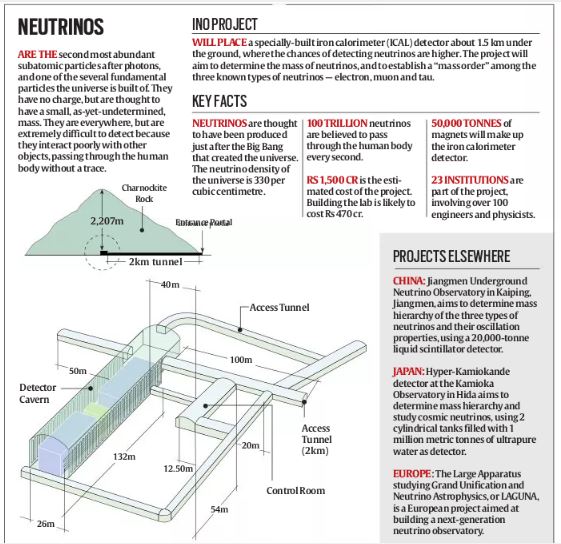What is the issue?
- Recentlty, the NGT has suspended the environmental clearance given to the India-based Neutrino Observatory (INO) which was to come up in the West Bodi Hills in Theni district in Tamil Nadu.
- Ever since the INO got approval from the Ministry of Science and Technology, it has been drawing flak from activists despite repeated assurances from scientists that it is unlikely to harm the environment or affect the livelihoods of the people.
What could happen now?
- The order of the NGT has forced the INO to seek fresh environmental clearance, and approval of the National Board for Wildlife.
- It is a process that could take upto 2 years, adding further to the delay that the project already faces.
- In the worst case scenario, the INO might even be forced to look for an alternative site, something that it has already had to do once earlier because of similar environmental concerns.
What is the reason behind opposition?
- The latest problem has been triggered by the NGT’s assessment that the INO site lies at a distance of 4.9 km from a national park in Kerala’s Idduki district, at least 100 m inside the 5 km radius beyond which projects do not need National Board for Wildlife approval.
- While environmental issues do exist, at the heart of these objections is also fear and mistrust of science and scientists.
- Doubts range from questions of safety to the questionable potential for application of neutrino physics.
- Are neutrinos likely to harm people when they strike them? Will the tunnels made for the observatory be used to store nuclear waste? Are some of the questions that people need answers.
What are the responses from scientific community?
- These and other questions have been addressed and answered in the negative by scientists.
- On neutrino: Neutrinos from the sun are falling on us by the trillions every second.
- On nuclear waste: Storing radiating material will spoil all the chances of detecting neutrinos, which interact rarely.
- On usefulness: We cannot say at the point of invention how useful a discovery will be. Yet, we can certainly imagine and speculate how useful the science may be.
- Former President APJ Abdul Kalam said about how neutrinos could be used to recognize the signs of nuclear proliferation from a remote location.
- He also guessed how neutrinos could help in the search of dark matter and dark energy.
- Additionally, just like we have optical and radio astronomy, we can literally widen our horizons with neutrino astronomy.
What is the INO project?
- The neutrino observatory is the most ambitious scientific research facility that India is trying to build.
- To be located 1.5 km below the Earth’s surface, this observatory would be used to detect and study neutrinos, one of the fundamental particles of the universe.
- Several groups in different countries are carrying out parallel research on neutrinos, which are believed to hold very important clues to some of the basic questions on the universe.
- In recent years, neutrino research has led to the Nobel Prize in Physics in 2002 and 2015.
- Detected for the first time in 1959, though their existence was predicted almost three decades earlier, in 1931, neutrinos were later found to be omnipresent.
- They are the second most abundant particles in the world, after photons.
- These high-energy particles are produced in natural radioactive decays and all sorts of nuclear reactions happening in nuclear power reactors, particle accelerators or nuclear bombs.
- But the most common source of neutrinos are celestial phenomena i.e., the birth and death of stars, collisions and explosions happening in space.
- The core of the Sun is an important source of neutrinos.
- A large number of the neutrinos were produced at the time of the Big Bang, making them good candidates to extract more information from about the origins of the universe.
- But because they are electrically neutral and almost massless, these neutrinos have an extremely low tendency to interact with other objects.
- This is the reason why scientists have to go deep underground to set up special detectors in a bid to catch the faint signals of neutrinos in an environment that is relatively free from ‘noise’ and disturbance.

Source: The Hindu & The Indian Express
